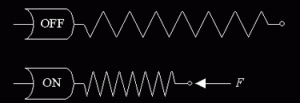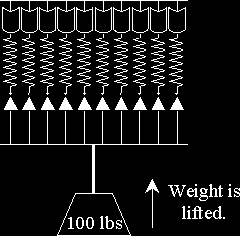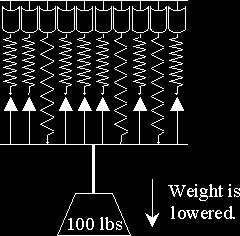Introducing The Negatives
Mechanical loading of your muscles is one of the key principles on which your training should be based. For a long time, however, muscle fatigue has been relied upon as a gauge for the effectiveness of one’s training.
According to tradition, one must work the muscles to momentary muscular failure so as to cause as many muscle fibers as possible to receive a growth stimulus.
Often it is suggested that the fast-twitch, or white, muscle fibers are not even called into action until the last few repetitions of a set. As discussed in support of Hypertrophy-Specific Training, however, a great deal of research suggests that all types of muscle fibers are called into action when the muscles are exposed to heavy enough loads. Because of this, HST emphasizes the heavy mechanical loading of the muscles rather than staying with the lighter weights proposed by many other training programs.
According to the HST convention, you should spend at least a portion of your training with heavy loads approaching your 5 rep max (RM) weight [1-3]. For those readers that are new to the iron game, an RM specifies the maximum number of times you can lift a weight before hitting muscular failure. For example, once you know how much weight you can bench press five times, that weight is called your 5RM for the Bench Press.
One way to increase the mechanical loading of your muscles beyond your 5RM is by performing eccentric repetitions, or negatives, with your 3RM or 2RM weights. With negatives, you typically have a partner help you lift the weight and then you lower the weight under control. You may choose to perform five negative repetitions of each exercise or you may choose to perform two concentric, or positive, repetitions followed by three negative repetitions where your partner helps you lift the weights.
Negatives are frequently touted as by far the most effective approach to muscle growth after having worked up to your 5RM with positives. Herein, a simple model is provided to demonstrate the effectiveness of negative repetitions.
Nerves & Muscle Fibers
Muscles are comprised of many muscle fibers. When the muscles are needed for exerting forces against objects, such as a barbell, the brain sends signals to the muscles via nerves. These signals cause the muscle fibers to shorten, or contract. The precise science underlying muscle physiology is very complex and goes far beyond our present needs. For this reason, we’ll rely on the simpler concept of “motor units.”
A motor unit is defined as all the muscle fibers that are innervated by a single nerve cell, called a neuron. Figure 1 illustrates an ultra-simplistic representation of such a motor unit. When the motor unit is turned “OFF” (i.e., no signal is transmitted by the neuron), the motor unit is not contracted and remains relaxed.
When the motor unit is turned “ON,” it contracts fully, creating a mechanical force F. For a more detailed discussion of muscle function.
 Figure 1: Motor unit deactivated and activated
Figure 1: Motor unit deactivated and activatedAn important feature of motor units is that each motor unit is either turned on and is fully contracted or turned off and fully relaxed. There is no way for the motor unit to be partially turned on or partially contracted. Activation and contraction of the motor unit is an all or none affair.
Another important feature is that not all of the motor units making up a given muscle are activated at the same time when the muscle contracts. Rather, a sufficient number of motor units are turned on so that the muscle exerts a required level of force. For instance, fewer motor units are required to lift a spoon to your mouth than to curl your 2RM weight.
Moreover, when you lift a heavyweight some of the motor units will begin to fail and turn off. To maintain the force output of the muscle, other motor units are turned on to take the place of the failed motor units. Thus, during muscular contraction, there is a continual turnover of motor units being activated, failing, and being replaced by other motor units and so on.
Recruiting Motor Units In Negatives
The act of turning on motor units to exert a muscular force is referred to as “recruitment” of the motor units. When you contract a muscle to lift a weight, you recruit a large number of motor units which exerts a combined, total force that is greater than the downward force of the weight. The weight moves upward simply because the muscular force is greater than the downward force of the weight.
Fewer motor units are recruited to hold the weight in a stationary position, called an isometric contraction. For an isometric contraction, you recruit just enough motor units to produce a total muscular force which is essentially equal to the downward force of the weight. Because the upward muscular force and the downward force of the weight are equal, the weight remains in the stationary position.
You lower the weight by turning off some motor units. This decreases the force exerted by your muscles on the weight. Once the downward force of the weight is a bit greater than the muscular force, the weight moves downward under control. Thus, fewer motor units are recruited to lower the weight under control than to hold the weight stationary.
A motor unit performs work when it contracts against an external load, such as a barbell. The load also exposes the motor unit to tension, which damages the motor unit. The motor unit receives a consequent growth stimulus that causes hypertrophy of the motor unit when it gets repaired.
The more tension placed on the motor unit, the greater is the growth stimulus experienced by the motor unit (within reason, of course). This is one reason why lifting heavy weights is more productive for muscle growth than staying with lighter weights.
The key to understanding negatives lies in the recruitment of motor units, discussed above. When motor units are turned off to lower a weight, a decreasing number of motor units are left holding the weight. These remaining motor units are thus exposed to a greater level of tension, which provides an opportunity for a greater growth stimulus. Let’s consider a simple example to see how this works.
 Figure 2: Turning on motor units lifts the weight
Figure 2: Turning on motor units lifts the weightSuppose you’re going to use a muscle comprised of ten motor units to lift a weight of 100 lbs. When you lift the weight, all of the motor units participate, as shown in Figure 2. Because all ten motor units participate, the weight exposes each motor unit to 10 lbs of tension. Once you’ve lifted the weight, you lower it by turning off some motor units. Let’s suppose that you turn off three motor units, as shown in Figure 3.
 Figure 3: Turning off motor units lowers the weight
Figure 3: Turning off motor units lowers the weightThis leaves seven motor units to lower the weight under control. Because there are now fewer motor units supporting the weight, each motor unit is exposed to more tension. In this example, each motor unit experiences about 14.3 lbs of tension while lowering the weight. This is an increase in tension of about 43% over that experienced during the concentric portion of the lift!
Since each motor unit is exposed to greater tension during the eccentric portion of the lift, the eccentric portion is a bit more inclined to produce a growth stimulus.
Clearly, performing negatives can lead to muscular growth more quickly than concentric or isometric repetitions. Of course, the model described above is pure fiction; you’re not guaranteed to increase your muscle growth by 43% just by doing negatives.
The primary advantage of doing negatives, however, is that not only do your muscles experience greater tension during the eccentric portion of a lift, but also you can generally lower more weight under control than you can lift. Thus, doing negatives is one way you can expose your muscles to greater levels of tension than experienced during concentric lifts.

